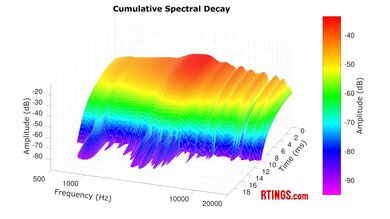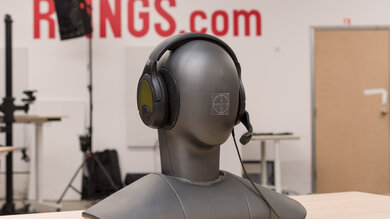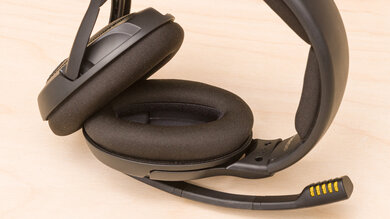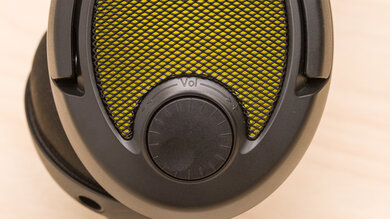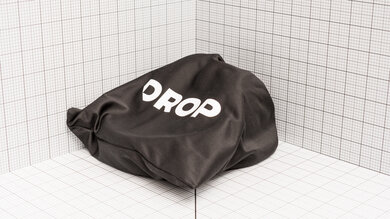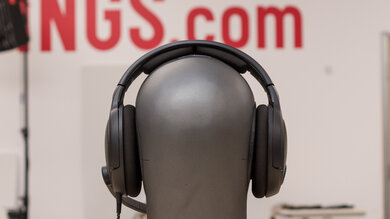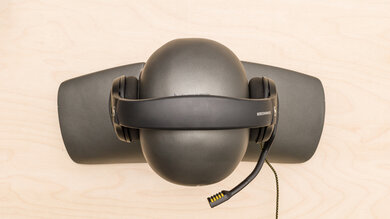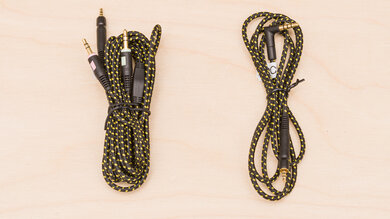The Drop + Sennheiser/EPOS PC38X are wired open-back gaming headphones. They were originally a collaboration between Drop and Sennheiser; however, EPOS took over the production of these headphones after splitting from Sennheiser Communications, so you may encounter this model listed as a product of either manufacturer. That said, only the name has changed; both products are the same and have the same Sennheiser drivers. They also look and perform fairly similarly to the Sennheiser Game One Gaming Headset, with an indented volume wheel and open-back design.
Our Verdict
The Drop + EPOS PC38X are sub-par for sports and fitness. These headphones aren't designed for this use case, so it's expected that they lack an IP rating for water resistance. They can also fall off your head with moderate movement, and since they have a wired design, the cable can be a snagging hazard.
-
Very comfortable fit and feel.
-
No IP rating for water resistance.
-
Can fall off your head with moderate movement.
The Drop + EPOS PC38X are poor for commuting and travel. They have an open-back design, so they leak a lot of audio at high volumes, which can disturb others around you, and they don't block out any rumbles from bus or plane engines. They're also quite bulky, and their pouch doesn't protect them when you're on the move. On the upside, they have a very comfortable design and feel well-built.
-
Very comfortable fit and feel.
-
Bad noise isolation performance.
-
Leaks audio by design.
The Drop + EPOS PC38X are middling for office work. They're open-back headphones, so they don't block out office chatter and leak audio at high volumes. This can be distracting for you and your coworkers if you don't work in a controlled environment like a home office. However, they have a very comfortable design and a great microphone, which is nice if you tend to take calls at work.
-
Excellent recording quality.
-
Very comfortable fit and feel.
-
Bad noise isolation performance.
-
Leaks audio by design.
-
No multi-device pairing.
The Drop + Sennheiser PC38X are wired-only headphones; you can't use them wirelessly.
The Drop + Sennheiser PC38X are good for wired gaming. These headphones have a comfortable fit, and their flip-down boom mic captures your voice clearly, even in moderately noisy environments. Unlike most gaming headsets, they have an open design, which can make your listening experience feel more spacious. Their wired analog design also ensures a virtually latency-free gaming experience, but this comes at the cost of companion software and limited controls. Our unit performed poorly in some aspects of stereo matching, causing audio cues like footsteps to lean to the left. While driver matching is a function of quality control and varies from unit to unit, it's worth looking out for similar issues if you have these headphones.
-
Excellent recording quality.
-
Very comfortable fit and feel.
-
Can fall off your head with moderate movement.
The Drop + Sennheiser PC38X have good audio reproduction accuracy. Their frequency response doesn't deviate much from their flat sound profile except in the treble, where highs and lows in neighboring bands can render sibilants alternately dull or piercing. The headphones reproduce transparent transients throughout the measured frequencies, with minor notches in group delay manifesting as mostly inaudible dips in the headphones' frequency response. That said, the drivers are inadequately matched with an audible bias toward the left driver, shifting sound cues off-center. You won't encounter audible harmonic distortion at typical listening volumes as the headphones render clean audio. While their design affords some outer ear interaction, it won't sound as natural as an angled stereo speaker setup.
The Drop + Sennheiser/EPOS PC38X have bad noise isolation performance. Their open design allows most audio out and most noise in—people nearby will hear your audio leak from the headphones, and you won't be isolated from background conversations or noisy environments.
The Drop + Sennheiser/EPOS PC38X has a great microphone. You'll remain intelligible even with significant background noise, and your voice will sound full-bodied and natural.
The Drop + Sennheiser/EPOS PC38X has good frequency response consistency. If you take the time to establish a good fit, the headphones' audio delivery will match our frequency response measurements.
- 5.9 Sports And Fitness
- 4.8 Travel
- 5.7 Office Work
- 5.6 Wireless Gaming (In Development)
- 7.6 Wired Gaming (In Development)
Performance Usages
- 7.6 Audio Reproduction Accuracy
- 1.7 Noise Isolation
- 8.0 Microphone (In Development)
- 7.6 Frequency Response Consistency
Changelog
-
Updated May 22, 2025:
This review has been updated to Test Bench 2.0, which adds the following tests: Stereo Mismatch, Group Delay, Cumulative Spectral Decay, PRTF, Harmonic Distortion, and Electrical Aspects. We've added new performance usages and updated the text throughout the Sound tests and side-by-sides.
- Updated May 14, 2025: We've converted this review to Test Bench 2.0, which updates our sound tests and adds performance usages. You can read more about this in our changelog.
-
Updated Nov 25, 2024:
Several Sound tests have been updated following TB 1.8. There have also been text changes made throughout the review, including the usages and product comparisons to match these results.
- Updated Nov 19, 2024: We've converted this review to Test Bench 1.8, which updates our target curve and Sound tests. You can read more about this in our changelog.
- Updated Jul 12, 2024: We've converted this review to Test Bench 1.7, which updates our Noise Isolation test. We've also expanded the scope of this test to include Common Scenarios in addition to Voice Handling and Wind Handling.
Differences Between Sizes And Variants
When these headphones were first released, their name was the Drop + Sennheiser PC38X. However, in 2020, Sennheiser Communications dissolved their joint venture, creating two different brands: Sennheiser and EPOS. EPOS manufactures gaming and business products and even produces co-branded EPOS | Sennheiser products under a trade license agreement. As a result, you may see these headphones listed as 'Drop + Sennheiser' or 'Drop + EPOS.' However, both models are exactly the same and come in two color variants: 'Black,' which is an all-black colorway, and 'Yellow,' which is a black model with yellow accents.
If you encounter another variant, please let us know in the comments, and we'll update our review.
Compared To Other Headphones
The Drop + Sennheiser PC38X are open-back gaming headphones made in collaboration with Drop and Sennheiser/EPOS. They offer a similar overall performance to the Sennheiser Game One Gaming Headset, although they come with an additional pair of velour earpads. However, they lack features like an EQ and microphone settings found on software-supported gaming headphones like the Astro A50 X. If you're looking for a similar pair of open-back gaming headphones with a less steep price, it could be worth it to check out the Drop + Sennheiser/EPOS PC37X, which have a slightly different look.
Check out our recommendations for the best gaming headphones, the best headsets for PS5, and the best headsets for Xbox Series X|S.
Whether the Sennheiser HD 560S are better than the Drop + Sennheiser/EPOS PC38X depends on whether you need a microphone. Both headphones are similarly tuned and have a comfortable fit. The HD 560S's L/R drivers are better matched than the PC38X we tested. However, the PC38X are the better pickup if you need a one product solution for multiplayer gaming. They have a flip-down boom mic with excellent recording quality and feel better built.
The Corsair VIRTUOSO PRO and the Drop + Sennheiser/EPOS PC38X have similar strengths, and your choice will depend on personal preference. Both are open-back, wired headphones designed with gaming use in mind. The Corsair have a bassier sound signature, which some might prefer, but the Drop + Sennheiser are more comfortable and have better mic recording quality. Both feature non-detachable boom mics, but the Corsair's mic is attached to a cable, which can easily be swapped out for a mic-less one for a more casual look.
The Drop + Sennheiser/EPOS PC38X perform similarly to the Sennheiser Game One Gaming Headset. While both headphones are well-built and comfortable, the Sennheiser have a slightly better overall boom mic performance. However, the Drop have an additional pair of ear pads in a different finish which you might like.
The Philips SHP9500 and the Drop + Sennheiser/EPOS PC38X have different strengths. The Philips have a brighter sound profile and are more comfortable. However, the Drop have a boom mic that captures your voice clearly, even in moderately noisy environments. They're also better built and have a bit more low-end and a warmer treble response.
The Drop + Sennheiser/EPOS PC38X and the Turtle Beach Atlas Air are both solid open-back gaming headphones. You can only use the Drop headphones via a wired connection, but they're more comfortable and have superior imaging that demonstrates better quality control. On the other hand, the Turtle Beach can be used wirelessly with PCs and PlayStations, have a companion app to adjust their sound profile, and have a better-performing microphone system.
While the Sennheiser HD 599 and the Drop + Sennheiser/EPOS PC38X are both great headphones for detailed listening, the Drop are specifically designed for wired gaming. Their boom mic records your voice clearly, even in moderately noisy environments. These headphones are also better built and have volume and mic controls. However, the HD 599 are more comfortable.
While the Beyerdynamic DT 990 PRO and the Drop + Sennheiser/EPOS PC38X are both great choices for critical listening, the Drop are a better choice for wired gaming. The Drop have volume controls and a boom mic to record your voice with body and clarity. They're also more comfortable. However, the Beyerdynamic are better built. The Beyerdynamic also have a touch more high-bass, which you might miss from the flatter-sounding Drop.
The Logitech G Pro X Gaming Headset offer a more customizable wired gaming experience than the Drop + Sennheiser/EPOS PC38X. The Logitech are compatible with G HUB software, which allows you to customize their sound using a graphic EQ or presets. They can also be used with a wired USB connection. However, the Drop have a more immersive passive soundstage and a better overall boom mic performance.
The Astro A40 TR Headset + MixAmp Pro 2019 are better wired gaming headphones than the Drop + Sennheiser/EPOS PC38X. While both headphones are comfortable, the Astro have better controls, are better built, and are compatible with Astro Command Center software, which allows you to customize their sound using a graphic EQ and presets. That said, some users have reported issues when using the companion software. They also have a virtual soundstage feature, but the simpler plug-and-play operation of the Sennheiser may be more appealing to some.
The SteelSeries Arctis Pro Wireless are better overall gaming headphones than the Drop + Sennheiser/EPOS PC38X. The SteelSeries have a virtual soundstage feature, though we don't currently test its performance, and their mic has a better noise-handling performance. They can also be used wirelessly, support Bluetooth for more casual use, and are compatible with SteelSeries Engine software, which offers a graphic EQ and presets to help adjust their sound to your liking. However, the Drop + Sennheiser/EPOS are more comfortable and have lower latency when wired.
The Sennheiser HD 6XX and the Drop + Sennheiser/EPOS PC38X are both great choices for critical listening, but the Drop are more suitable for wired gaming. The Drop have a boom microphone that's able to capture your voice clearly, even in noisy environments. They're also more comfortable and have volume as well as mic controls.
Test Results
These headphones have a flat sound profile with the included microfiber ear cups. Their signature more closely resembles the SoundGuys.com Studio Curve than our own target, which is to be expected from most open-back headphones that roll off in the bass. If you swap out the microfiber padding for velour padding, you'll get a touch more bass and a slight boost in airiness due to added high-treble. However, vocals and instruments are slightly more veiled due to a dip in the low-treble. There's no difference in noise isolation or leakage, though. You can see a frequency response comparison between the velour pads and the microfiber pads. The added bass may be preferable for single-player RPG titles, where you might prefer a bass bump in cinematic cutscenes.
Their frequency response consistency is good. They deliver bass and mids consistently, though there is some contrary motion in the high-mids between the L and R graphs. This has more to do with deviations between the drivers' frequency response than fit and positioning, though.
These over-ears have decent bass target compliance. While they lack a thumpy low-bass and the mid-bass is a touch recessed, the high-bass is virtually flat, so groovy basslines sound full and warm, and sound effects like footsteps are reproduced well.
The Drop + EPOS PC38X have outstanding mid-range target compliance. The range is very flat and even. As a result, impactful dialogue in games like Baldur's Gate 3 and lead instruments in soundtracks are accurate, clear, and detailed.
The Drop + Sennheiser PC38X have good treble target compliance. The low-treble mostly matches our target, so dialogue and lead instruments sound present and detailed. However, a general downward tilt continues through the mid- and high-treble. This takes the edge off most sibilants but can also make instruments like cymbals feel a bit dull or closed off.
The peaks and dips performance of these headphones is excellent, meaning the headphones' frequency response deviates little from their flat profile. The bass and mid-range are both smooth, with most deviations present in the inconsistent treble range. This can cause sibilants to sound alternately harsh or piercing, as neighboring bands fluctuate from high to low relative to one another.
The headphones' L/R drivers are inadequately matched. The headphones' frequency response and amplitude mismatch notably favor the left channel throughout the entire bass and mid-range. The L/R drivers also deviate from one another in the mid- and high-treble, though this isn't as audible as we lose sensitivity to higher frequencies over time. In practice, you'll notice sound objects like vocals and instruments reproduced off-center and pulled to the left. While there are minor differences in phase response between the drivers in higher frequencies, you likely won't perceive reduced precision of high-pitched harmonics from hi-hats and sopranos. It's worth pointing out that stereo matching is a measure of quality control, so your headphones may be better matched than the ones we tested.
The group delay performance is good. The headphones reproduce tight bass and transparent treble. That said, minor notches in the group delay performance are indicative of phase shifts relative to neighboring frequencies, which results in constructive and destructive wave interactions. As a result, notches appear in the frequency response for the affected bands.
While the headphones' PRTF measurements indicate some pinna interaction, it doesn't closely resemble our reference curve meant to simulate an angled stereo speaker setup. As a result, the headphones probably won't sound as natural or immersive as the Sennheiser HD 800 S.
These headphones have remarkable harmonic distortion. While the weighted graph shows high levels of bass range distortion, you likely won't perceive coloration from these harmonics due to our lack of sensitivity to lower frequencies. Meanwhile, the headphones reproduce audio cleanly at typical listening volumes in the treble and mid-range.
These headphones don't need an amp. Mobile devices and laptops can drive the headphones at high listening levels.
These are the settings used to test these headphones. Our results are only valid in this configuration.
The Drop + Sennheiser PC38X look very similar to the Sennheiser Game One Gaming Headset. The frame has a gray satin finish, while the ear cups and mic have primary yellow accents. These headphones are available in this color scheme or in an all-black colorway called 'Black.' Unfortunately, you can't detach the mic for a more casual look, and the mic isn't attached to a swappable cable the way it is with the Corsair VIRTUOSO PRO.
The Drop + EPOS PC38X are very comfortable. Even though these headphones have a high clamping force, you don't feel it, and they feel light on your head. The headband is comfortable enough for long gaming sessions, and you can swap out the microfiber ear pads for ones with velour padding included in the box.
The controls are quite limited. Like the Sennheiser Game One Gaming Headset, there's only one control: a volume wheel on the right ear cup. You can also flip the mic upwards to mute it. The volume wheel has a circular indentation to help you turn the wheel, and it stops when you've reached the min and max volume. However, it can be tricky to tell which direction raises or lowers the volume when you're wearing them.
These over-ears aren't very portable. The headphones can't fold into a more compact form, and their ear cups don't swivel to lay flat. They also have a bulky design, making it harder to take them with you on the move. Their carrying case doesn't offer a lot of additional protection either.
These headphones are well-built. The frame is mostly made of plastic with metal grilles on the ear cups to allow sound to escape the cup. The braided audio cable feels very sturdy, too. Overall, they feel like they'll survive accidental drops and falls without taking too much damage. However, their headband also feels like a weak spot and could be prone to breaking over time.
The Drop + Sennheiser PC38X's noise isolation performance is bad, but this is due to their open-back design. They aren't designed to block out sounds like car engine rumbles from an open window or ambient chatter from roommates. They barely reduce the high-pitched whirl of computer fans, too.
These headphones have a poor leakage performance. Their leakage is concentrated across a broad range and sounds fuller than that of closed-back headphones. If you're listening to audio at a high volume, others around you can hear your audio.
The mic's recording quality is excellent. Your voice sounds clear, full-bodied, and easy to understand.
The mic has good noise handling. It can separate your voice from moderate ambient noise around you, so you won't have too much of a problem being understood by your teammates and enemies.
These headphones come with a 1/8" TRRS to 1/16" TRRS cable and a Y-splitter to 1/16" TRRS cable. Both TRRS connections ensure a nearly latency-free experience, so your audio and visuals will be in sync while gaming.
The Drop + Sennheiser PC38X have full audio and mic compatibility on PCs when using the analog cable.
If you plug their audio cable into your PlayStation console's AUX port, you'll have full audio and mic compatibility.
The Drop + Sennheiser PC38X have full audio and mic compatibility on Xbox One and Xbox Series X|S consoles via an analog connection.


